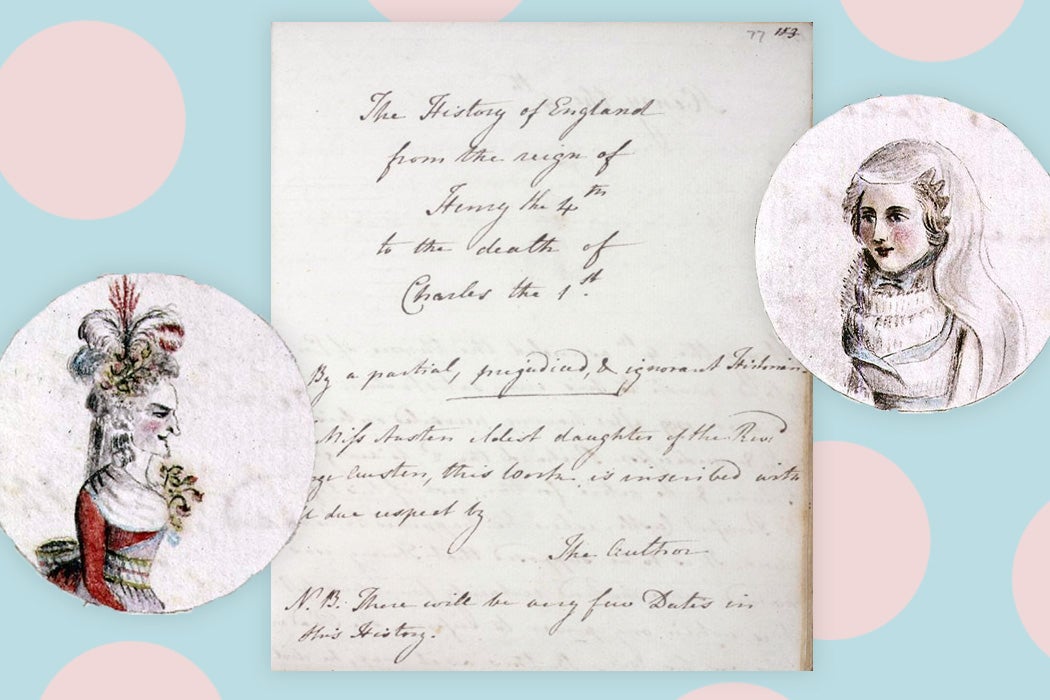“By a partial, prejudiced, and ignorant historian.” Who else but Jane Austen could start a book with such a cheeky line? Austen opens The History of England with these words, and she would just get funnier from there. “There will be very few dates in this history,” she warns her readers in her introduction. Anyone looking for a more serious historic text should look elsewhere. She was not writing to teach, but to express herself, in her own satirical way.
Austen was only fifteen years old when she wrote The History of England in 1791, but she was already finding her footing as a writer and sharp-witted social commentator. In her adolescence, the prospect of publication was not yet her ultimate goal. She was writing mainly as a form of self-amusement and for her family’s private entertainment, which allowed her a high degree of freedom for developmental experimentation with form, style, and subject matter. She had multiple juvenilia projects in process, one of them a sarcastic history textbook that poked fun at the prevailing stiff approaches and attitudes towards recounting past events. According to Austen researcher Misty Krueger, “Many scholars have identified Austen’s History as a parody of history writing, particularly that of Oliver Goldsmith’s History of England from The Earliest Times to the Death of George II (1771) and his abridgement of those volumes (1774).” It’s likely that Austen, having read the book as part of her rigorous self-education regime, put the dull tome down with a weary sigh and thought to herself, “I can do better.”
Jane Austen, as per usual, was boldly opinionated towards her topic of choice, and uninterested in presenting romanticized versions of anyone or anything. The History of England gives readers a mocking tour through the tenures of England’s monarchs by a guide who isn’t at all shy about which ones she prefers and which ones she finds distasteful. “It would be an affront to my Readers were I to suppose that they were not as well acquainted with the particulars of this King’s reign as I am myself,” she explains in her consideration of King Henry VIII. “It will therefore be saving them the task of reading again what they have read before, & myself the trouble of writing what I do not perfectly recollect, by giving only a slight sketch of the principal Events which marked his reign.”
The young Austen had a particular interest in the vilified Stuart dynasty, and her work reflects the spirit of a rebellious young crusader seeking overdue justice for a cause. History had been violent and partisan to the Stuarts; Austen would reassemble their mutilated reputation with her writing without sacrificing her own sense of humor in the process.
“Austen offers her readers a multivalent, multimodal text that encompasses parody and historiography, yet engages with the with the traditions of martyrology and vindication, or defense,” notes Krueger.
Austen’s earnest efforts were most devoted to Henry VIII’s daughter Elizabeth I and her execution of her cousin Mary, Queen of Scots. Austen points an accusatory finger at Elizabeth’s advisors for allowing her “to bring this amiable Woman [Mary] to an untimely, unmerited, and scandalous Death.” When Austen labelled herself as “partial and prejudiced,” she meant it. Wholeheartedly.
Weekly Newsletter
The History of England was an artistic collaboration. Austen’s older sister Cassandra, an amateur watercolorist, was recruited to provide illustrations for the text. Cassandra, intelligent and talented in her own right, seemed to have fully understood the nature of the assignment. Her depiction of Elizabeth I is that of a sneering, scheming, witch-like figure with a hooked, crooked nose. Mary, Queen of Scots, is a perfect, innocent-looking fairy-tale princess with a doll-like, heart-shaped face. One can easily imagine Jane and Cassandra sharing a good laugh over their two-person smear campaign against the revered Elizabeth who, in their eyes, was the villainess, not the heroine, in history.
Jane Austen would eventually pursue a career writing fictional (and more three-dimensional) heroines, and her brief stint as a historian matched the extent of the work itself, which spanned only thirty-four pages in the manuscript of Austen’s early writings titled “Volume the Second.” Austen may have realized later in life that being “partial, prejudiced, and ignorant” didn’t allow her to explore the full potential of her literary abilities after all.
Support JSTOR Daily! Join our new membership program on Patreon today.







